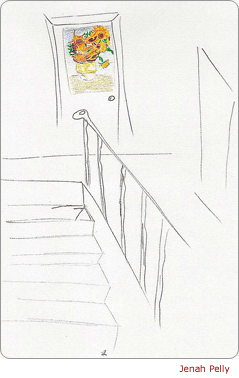|
On the fairly time-worn door to my third floor apartment I tacked up a poster of Van Gogh's Sunflowers.
 Since Van Gogh did a series of such works, before I started to write this paragraph I thought it might be a good idea to find out the name of this painting. As it turns out, from quick Internet Van Gogh perusal, I learned that the particular poster I have is called "Vase With Fifteen Sunflowers," the original of which is in Tokyo, Japan. I also learned that there are two other paintings of the same name. Of the three, two were done in January 1888 and one in August 1888 which, depending on the canvas, might explain the changing state of the blossoms, from full to dried. Since Van Gogh did a series of such works, before I started to write this paragraph I thought it might be a good idea to find out the name of this painting. As it turns out, from quick Internet Van Gogh perusal, I learned that the particular poster I have is called "Vase With Fifteen Sunflowers," the original of which is in Tokyo, Japan. I also learned that there are two other paintings of the same name. Of the three, two were done in January 1888 and one in August 1888 which, depending on the canvas, might explain the changing state of the blossoms, from full to dried.
Apparently, Van did seven paintings altogether using the sunflower motif between 1888 and 1889 while living in Arles, and it seems that five of these paintings depict variations of the same vase, though the number of sunflowers ranges from three on up. Van Gogh also did four sunflower paintings in 1887 while a resident of Paris, but these were cut flower studies focusing more on the flow of petals without the centering of a vase at all. I also learned that of the series, one painting, "Vase With Sunflowers," was destroyed by fire in World War II. Only a print remains, and it strikes me as amazing that it seems such a decent one at that. It also strikes me as fitting that Tokyo should be home to one of these masterpieces given Van Gogh's love of and experimentation with oriental themes. An odd parallel though, the fire, for I can easily picture the engulfing flames of Hiroshima or Nagasaki, flames as orange and yellow, as blue and red, as the heat in one of Van Gogh's canvases.
I look at the print on my door and can literally feel the blaze of Van Gogh's energy, the intensity of obsession, the passion given form and release. How, like Blake's tiger burning bright, the cauldron of those images must have been radiant in Van Gogh's nervous system, a light in his mind, a harvest light from summer to autumn. The fact that he was still painting the theme in January means Vincent must have carried it quite like a torch, and also been carried, quite like a vessel, with the inspiration of that brilliance. The blood in the artist's hands as he arranged and rearranged the stems, as he picked up his
brushes and orchestrated from paint to surface, both the math and the music of such industry reveals Van Gogh to have been like a conductor, and thus the strokes of his works still vibrant with a kind of breathing, almost audible flesh.
It can easily be seen in his portraits, the pinpoint microcosm of his gaze, that planetary blue of world unfolding from world. Even his whiskers are like antennae picking up and issuing back electricity.
Sometimes I wonder what life would be like for a Van Gogh today. Would he have a good therapist, reliable 12 step group, and an adequate dose of Prozac? Would he still be as driven or would the bio-chemicals be harnessed? Which proceeded which? After all, it's not as if the man lacked focus. He seems to have suffered from an abundance of it. This certainly strikes up sympathetic chords of the caregiver in me.
Still, if he presented me with his ear, I don't know if I would quite have the compassionate, stellar calm to say, "Oh now, you poor dear, really, you shouldn't have," and start winding about the bandages. Perhaps it would be more a matter of "Save your energy and stalk elsewhere, Van. Time to take out a court order. Sorry!"
But of course that's all just speculative games of pretend. In reality Van Gogh's Sunflowers still light up my front door as more true and more full of heart than any other welcome.

|
